Gaeta
Gaeta
Gaieta | |
|---|---|
| Comune di Gaeta | |
 Gaeta view from sea | |
| Coordinates:41°13′N13°34′E/ 41.217°N 13.567°E | |
| Country | Italy |
| Region | Lazio |
| Province | Latina(LT) |
| Area | |
| • Total | 29.2 km2(11.3 sq mi) |
| Population (2018-01-01)[2] | |
| • Total | 20,545 |
| Demonym | Gaetani |
| Time zone | UTC+1(CET) |
| • Summer (DST) | UTC+2(CEST) |
| Patron saint | Saint Erasmus |
| Saint day | 2 June |
| Website | Official website |



Gaeta(Italian:[ɡaˈeːta];Latin:Cāiēta;Southern Laziale:Gaieta) is a city in theprovince of Latina,inLazio,Italy.Set on a promontory stretching towards theGulf of Gaeta,it is 120 kilometres (75 miles) fromRomeand 80 km (50 mi) fromNaples.
The town has played a conspicuous part in military history; its walls date toRoman timesand were extended and strengthened in the 15th century,[3]especially throughout the history of theKingdom of Naples(later theKingdom of the Two Sicilies).
Present-day Gaeta is a fishing and oilseaportand a renowned tourist resort.NATOmaintains a naval base of operations at Gaeta.
History[edit]
Ancient times[edit]
Ancient Caieta was situated on the slopes of the Torre di Orlando, a promontory overlooking theMediterranean Sea.It was inhabited by theOscan-speakingItalic tribeof theAurunciby the 10th-9th century BC. Only in 345 BC did the territory of Gaeta come under Rome's influence.[4]
Caieta with its ltemperate climate[5]like the neighbouringFormiaandSperlonga,became one of the earliest locations ofvillae maritimae,seasidevillasand luxurious retreats for the Roman elite owned, for example, byScipio Africanus(236-183 BC) andGaius Laelius.[6]Caieta was also linked to the capital of theRoman Empireby theAppian Wayand its extension theVia Flacca.
The remains of the monumental villa[7]ofLucius Marcius Philippus (consul 56 BC),stepfather ofAugustus,are in Hotel Irlanda in the Arcella area.[8]Lucius Munatius Plancus(consul in 42 BC) had a vast villa located on Monte Orlando overlooking the Gulf of Gaeta. His mausoleum, built at the end of the 1st century BC, is still an impressive monument inside a large clearing within the villa.[9]
Lucius Sempronius Atratinusprobably lived here as indicated by hismausoleum.[10]Atratinus wassuffect Consulin 40 and 34 BC,propraetorin Greece in 39 BC, and first admiral ofMark Antony's fleet from 38-34 BC.[11]
In theRoman imperial ageit continued as a popular resort for many important and rich characters ofRome.EmperorDomitian(r. 81-96 AD) also had a villa in the area.[12]
EmperorAntoninus Piusrestored the port, given its strategic relevance.[13]
Remains of an aqueduct that supplied the town from the Conca hill can be seen a few metres from the villa ofHortensius.[14][15]

Middle Ages[edit]
At the beginning of theMiddle Ages,after theLombardinvasion, Gaeta remained under thesuzeraintyof theByzantine Empire.In the following years, likeAmalfi,SorrentoandNaples,it would seem to have established itself as a practically independent port and to have carried on a thriving trade with theLevant.[3]
As Byzantine influence declined in Southern Italy, the town began to grow. For fear of theSaracens,in 840, the inhabitants of the neighbouring Formiæ fled to Gaeta. Though under the suzerainty of Byzantium, Gaeta had then, like nearby portsNaplesandAmalfi,a republican form of government with adux( "duke" or commanding lord under the command of the ByzantineExarch of Ravenna), as a strong bulwark against Saracen invasion.
Around 830, it became a lordship ruled by hereditaryhypatiorconsuls:[3]The first of these wasConstantine(839–866), who in 847 aidedPope Leo IVin thenaval fight at Ostia.At this same time (846), the episcopalsee of Gaetawas founded when Constantine, Bishop of Formiae, fled thither and established his residence. He was associated with his sonMarinus I.They were probably violently overthrown (they disappeared suddenly from history) in 866 or 867 byDocibilis I,who, looking rather to local safety, entered into treaties with the Saracens and abandoned friendly relations with thepapacy.Nevertheless, he greatly expanded the duchy and began the construction of the palace. The greatest of thehypatiwas possiblyJohn I,who helped crush theSaracensatGariglianoin 915 and gained the title ofpatriciusfrom the Byzantine EmperorConstantine VII.
The principle ofco-regencygoverned the early dynasties: Docibilis I associated John with him, and John, in turn, associated his sonDocibilis IIwith him. In 933, three generations were briefly co-ruling:John I,Docibilis II, andJohn II.On the death of Docibilis II (954), who first took the titledux,theduchypassed from its golden age and entered a decline marked by a division of territory. John II ruled Gaeta and his brother, Marinus, ruled Fondi with the equivalent title of duke. Outlying lands and castles were given away to younger sons, and thus the family of the Docibili slowly declined after the mid-century.
Allegedly, but improbably, from the end of the 9th century, theprincipality of Capuaclaimed Gaeta as a courtesy title for the younger son of its ruling prince. In the mid-10th century, theDe CeremoniisofConstantine VIIlists the ceremonial title "prince of Gaeta" among the protocols for letters written to foreigners.[16]
PrincePandulf IV of Capuacaptured Gaeta in 1032 and deposed DukeJohn V,assuming the ducal and consular titles. In 1038, PrinceGuaimar IV of Salernotook it from him and, in 1041, established theNormancounts of Aversa,who were afterwards princes ofCapua,aspuppetdukes. The native dynasty made a last attempt to wrest the duchy from Guaimar in 1042 underLeo I of Gaeta.
In 1045, the Gaetans elected their Lombard duke,Atenulf I.His son,Atenulf II,was made to submit to the Norman PrinceRichard I of Capuain 1062 when Gaeta was captured byJordan I of Capua.In 1064, the city was placed under a line of puppet dukes, appointed by the Capuan princes, who had usurped the ducal andconsulartitles. These dukes, usually Italianate Normans, ruled Gaeta with some level of independence until the death ofRichard III of Gaetain 1140. In that year, Gaeta was definitively annexed to theKingdom of SicilybyRoger II,who bestowed on his sonRoger of Apulia,who was duly elected by the nobles of the city. The town did maintain itscoinageuntil as late as 1229 after the Normans had been superseded by the centralisingHohenstaufen.
Gaeta, owing to its important strategic position, was often attacked and defended bravely in the many wars for possession of theKingdom of the Two Sicilies.In 1194 thePisans,allies ofEmperor Henry VIin the conquest of the kingdom, took possession of the city and held it as their own.
In 1227,Frederick II,who wasKing of Sicilysince 1198, was in the city and strengthened the castle. However, in the struggle between Frederick and thePapacy,in 1228, it rebelled against Frederick II and surrended to the pope after the Papal forces destroyed the castle in the fray. After the peace of San Germano of 1230, it was returned to the Sicilian kingdom. In 1233, Frederick regained control of the important port and fortress. Following the division between the Kingdom of Sicily, Gaeta became a possession of the newKingdom of Naples.In 1279Charles I of Anjourebuilt the castle and enhanced the fortifications. In 1289 KingJames II of Aragonbesieged the city in vain. From 1378 Gaeta hosted for some yearsantipope Clement VII.The future King ofNaplesLadislauslived in Gaeta from 1387. Here, on 21 September, he marriedCostanza Chiaramonte,whom he repudiated three years later.
KingAlfonso V of Aragon(as Alfonso I of Naples) made Gaeta his beachhead for the conquest of theKingdom of Naplesin 1435, besieged it, and to his disadvantage, displayed great generosity by aiding those unable to bear arms which had been driven out from the besieged town. After a disastrous naval battle, he captured it and gained control of the kingdom. He enlarged the castle, which became his royal palace, and created a mint. In 1451 the city was home to theTreaty of Gaeta,stipulated between Alfonso V and theAlbanianlord,Skanderbeg:the treaty ensured protection of the Albanian lands in exchange for political suzerainty of Skanderbeg to Alfonso.[17]
Modern era[edit]
In 1495, KingCharles VIII of Franceconquered the city and sacked it. The following year, however,Frederick of Naplesregained it with a tremendous siege which lasted from 8 September to 18 November. In 1501 Gaeta was retaken by the French; however, after theirdefeat at the Garigliano(3 January 1504), they abandoned it toGonzalo Fernández de Córdoba,Ferdinand II of Aragon's general.
In 1528Andrea Doria,admiral ofCharles V,defeated a French fleet in the waters off Gaeta and gave the city to its emperor. Gaeta was thenceforth protected with a new and more extensive wall encompassing Monte Orlando.
In theWar of the Spanish Succession,on 30 September 1707, Gaeta was stormed and taken after athree-month siegeby theAustriansunderGeneral Daun.On 6 August 1734, it wastakenby French, Spanish and Sardinian troops under the futureKing Charles III of Spainafter a stubborn defence by the Austrianviceroyof four months.[3]Charles' daughterInfanta Maria Josefa of Spainwas born here in 1744. The fortifications were again strengthened; in 1799, the French temporarily occupied it.
On 18 July 1806, the French captured it underAndré Masséna,after a heroic defence. It was created as aduché grand-fiefin the Napoleonic Kingdom of Naples, but under the French nameGaète,for finance ministerMartin-Michel-Charles Gaudin,in 1809 (family extinguished in 1841). On 8 August 1815, it capitulated to the Austrians after a three-months siege. It had been attacked and partially reduced by ships of the Royal Navy on 24 July 1815.
After his flight from theRoman Republic,Pope Pius IXtook refuge at Gaeta in November 1848. He remained in Gaeta until 4 September 1849.
On 1 August 1849,USSConstitutionwhile in port at Gaeta, received onboardKing Ferdinand IIand Pope Pius IX, giving them a 21-gun salute. This was the first time a Pope set foot on American territory or its equivalent.
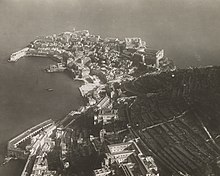
Finally, in 1860, Gaeta was the scene of thelast standofFrancis II of the Two Siciliesagainst the forces of United Italy. The king offered a stubborn defence, shut up in the fortress with 12,000 men and was inspired by the heroic example of QueenMaria SophieafterGiuseppe Garibaldi's occupation ofNaples.It was not until 13 February 1861 that Francis II was forced to capitulate when the withdrawal of the French fleet made bombardment from the sea possible,[3]thus sealing the annexation of the Kingdom of Naples to the Kingdom of Italy.Enrico Cialdini,the Piedmontese general, received thevictory titleofDuke of Gaeta.During the functioning of the Government ofMontenegroin exile from 1919 to 1924, that supported thePetrović-Njegoš dynastyand opposed the rule of thehouse of Karađorđevićin Yugoslavia (The Greens) were located in Gaeta.
Contemporary age[edit]
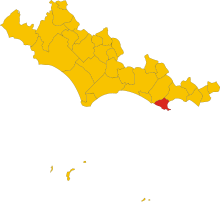
After theRisorgimentoand untilWorld War II,Gaeta grew in importance and wealth as a seaport. The nearby town of Elena, separated after the Risorgimento and named after the queen of Italy, was reunited with Gaeta followingWorld War I.Benito Mussolinitransferred Gaeta from the southern region known today asCampania(formerly Terra di Lavoro, to which it is historically and culturally attached) to the central region ofLazio.
After the king dismissed Mussolini in the summer of 1943, the latter was initially taken via Gaeta to the island prison ofPonza.After Italy surrendered to the Allies, however, the town's fortunes began to decline. Recognizing its strategic importance and fearing an Allied landing in the area, German troops occupied the city and expelled most of the population. The exclusion zone extended five kilometres from the historical city centre. Soon after, however, the population was expelled even beyond this point. The Gaetani were finally ordered to leave the area completely. Those who could not be placed in aconcentration campand a few were taken to Germany.
Following the Allied advance across theGarigliano Riverand the Allied occupation ofRome,the Gaetani were allowed to return to their city and begin the process of rebuilding. In subsequent decades the city has boomed as a beach resort, and it has seen some success marketing its agricultural products, primarily its tomatoes and olives. Many of its families count seamen among their number. However, the decades sinceWorld War IIhave been as difficult for Gaeta as they have been for most of Italy'sMezzogiorno.In particular, its importance as a passenger seaport has nearly vanished: ferries to Ponza and elsewhere now leave from the nearby town ofFormia.All attempts to build a permanent industry as a source of employment and economic well-being for the town have failed. Notable losses include the Littorina rail line (now used as a parking lot and a marketplace), theAGIPrefinery (nowadays a simple depot), and the once-thriving glass factory, which has become an unused industrial relic.
Gaeta does have a viable tourism industry, as it is a popular seaside resort. Its warm, rain-free summers attract people to its numerous beaches along the coastline, such as Serapo and Sant'Agostino's beaches. Nearly equidistant toNaplesand Rome, Gaeta is a popular summer tourist destination for people from both cities' metropolitan areas.
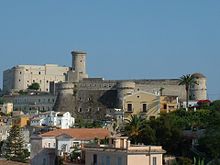

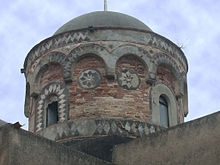
Main sights[edit]

The main attractions of the city include:
- The Aragonese-Angevine Castle. Its origins are uncertain: most likely it was built in the 6th century, in the course of theGothic War,or during the 7th century to defend the town from theLombards' advance. The first documents mentioning it date to the age of Frederick II of Hohenstaufen, who strengthened it in 1233. The current structure is made of two different edifices: the "Angevine"one, in the lower sector, dating to the House of Anjou's rule in the Kingdom of Naples; and the" Aragonese ", at the top, built by emperor Charles V, together with the other fortifications that made Gaeta one of the strongest fortresses in southern Italy. The Angevine wing housed a military jail until the 1980s (German war criminal officersWalter RederandHerbert Kapplerwere imprisoned here). Now it is a property of the Gaeta municipality, which uses it for conferences and exhibitions. In the dome of the tallest tower is the Royal Chapel, built by KingFerdinand II of the Two Siciliesin 1849.
- The Mausoleum ofLucius Munatius Plancus(22 BCE) is a cylindricaltravertinemonument at the top of Monte Orlando (168 m). It stands at 13.20 m and has a diameter of 29.50 m. Another importantRomanpublic man,Lucius Sempronius Atratinus,Mark Antony's fleet commander, has a mausoleum sited in the more recent district of Gaeta: of similar diameter; it is, however not as well preserved.
- The Sanctuary ofSS. Trinitàwas mentioned as early as the 11th century and visited, among the others, bySt. Francisand SaintPhilip Neri.The Crucifix Chapel was built in 1434 over a rock which had fallen from the nearby cliffs. From the sanctuary, theGrotta del Turcocan be visited: it is a grotto which ends directly in the sea and where the waves create atmospheric effects of light.
- Sanctuary of Santissima Annunziata- A church and adjacent hospital were built at the site in the 14th century but rebuilt at the beginning of the 17th century inBaroquestyle by Andrea Lazzari. It houses works by Renaissance painters includingAndrea SabbatiniandGF Criscuolo;as well as late-Baroque artists such asLuca Giordano,Sebastiano ConcaandGiacinto Brandi.The church has aGothic-style sarcophagus of Enrico Caracciolo. Also notable is theGolden Chapel or Grotto,aRenaissance-style chapel wherePope Pius IXmeditated before issuing thedogmaofthe Immaculate Conception.[18]The ceiling is gilded, and the walls contain 19 canvases (1531) byCriscuolo.The main altarpiece is anImmacolatabyScipione Pulzone.
- San Giovanni a Mare- The church was initially built outside the old sea walls by the hypate Giovanni IV in the 10th century. It combines thebasilicaform with theByzantineone. The simple façade has a Gothic portal and a dome, while the interior has a nave with two aisles. The inner pavement is slightly inclined to allow waters to flow away in the case of maritime floods.
- The Cathedral ofAssunta e Sant'Erasmowas erected over a more ancient church, Santa Maria del Parco, and consecrated byPope Paschal IIin 1106: it had a nave with six aisles separated by columns with Gothic capitals. In 1778, however, two of the aisles were suppressed, and the Gothic lines were hidden. In the 13th century, Moorish arches were added over the capitals. In 1663 the crypt was decorated in Baroque style. The interior houses a banner from theBattle of Lepanto,donated byPope Pius VtoDon John of Austria,who used it as his admiral's flag. The main sight of the church is, however, the marble Paschal candelabrum, standing 3.50 m tall, from the late 13th century: it is inRomanesquestyle, decorated with 48 reliefs in 4 vertical rows, telling theStories of the Life of Jesus.There are also paintings byGiacinto BrandiandGiovanni Filippo Criscuolo.The cathedral contains the relics ofSt. Erasmus,transferred from Formia; the remarkable campanile, in Arab-Norman style, dates from the 12th century. At the base are slabs and parts of columns from ancient Roman edifices.
- The Cathedral has a greatbell tower,standing at 57 m, which is considered the city's finest piece of art. The base has two marble lions, and the whole construction largely reused ancient Roman architectural elements. The upper part, octagonal in plan, with small Romanesque arches with majolica decoration, was completed in 1279.
- The Chapel of the Crucifix is a curiosity: built on a huge mass of rock that hangs like a wedge between two adjoining walls of rock. Legend tells how the rock was thus split at Christ's death.
- San Francesco- According to the legend, the church was constructed by the saint himself in 1222. In reality, Frederick II ordered the construction. The church features a fine Gothic-Italian style and hosts paintings and sculptures by many of the most famous Neapolitan artists.[citation needed]
- The parishchurch of Santa Lucia,the formerSt. Maria in Pensulis,was once a Royal chapel and here prayedMargaret of Durazzoand KingLadislaus.It originally had Romanesque andSicilian-Arablines, but in 1456 it was rebuilt in Renaissance style and 1648 adapted to a Baroque one. The site has a Mediaevalpronaoswith ancient fragments and figures of animals.
- The Medieval Quarter of Gaeta is itself of interest. It lies on the steep sides of Mount Orlando and has characteristic houses from the 11th-13th centuries.
Gaeta is also the centre of the Regional Park ofRiviera di Ulisse,which includes Mount Orlando,Gianolaand theScauriMounts, and the two promontories of Torre Capovento andTiberius' Villa inSperlonga.
[edit]
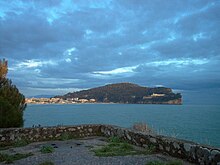
In 1967, the homeport of the U.S. Sixth Fleet flagship relocated fromVillefranche-sur-Merto Gaeta.[19]Support facilities were established in Mount Orlando. This was done following the transfer of the responsibilities of Lead Nation for NATO Naval Forces in the Mediterranean from the United Kingdom to the United States. TheBritish Mediterranean Fleetwas abolished - its former base inMaltawas no longer exclusively under British control due to that nation having achieved independence from the UK.
It is currently used as the home port for the flagship of the United StatesSixth Fleet.The Sixth Fleet commander, typically a 3-Star US Navy Vice-Admiral, has operational control of Naval task forces, battle groups, amphibious forces, support ships, land-based surveillance aircraft, and submarines in the Mediterranean Sea. Gaeta's role has been important since the early 19th century to the US Navy's commitment to forward presence.Pope Pius IXandKing Ferdinand IIof theKingdom of Two Sicilies,paid visits to theUSSConstitutionwhile in Gaeta in 1849. Nine ships have been stationed in Gaeta, with the primary mission of serving as the flagship for theSixth Fleetcommander. The first was theUSSLittle Rock(CG-4).Other Sixth Fleet flagships includedUSSSpringfield(CLG-7),USSAlbany(CG-10),USSPuget Sound(AD-38),USSCoronado(AGF-11),USSBelknap(CG-26)andUSSLa Salle(AGF-3).The current flagship is theUSSMount Whitney(LCC-20).
The town is host to the families of the crews who work on the ship. There was aDOD schoolforAmericanchildren and the US Naval Support Activity, Gaeta, which provided health care and other services until it was closed down in 2005. The NATO base itself was located on Monte Orlando, which overlooks the Gulf of Gaeta. It has recently been transferred to a shore-based facility where the Commander Sixth Fleet also operates.
Culture[edit]
Gaeta has erected a monument toJohn Cabot,who discovered Canada in 1500. Other people associated with the town include the paintersGiovanni da GaetaandGiovanni Filippo Criscuolo.For a full list, seePeople from Gaeta.
Gaetans speak a dialect of Italian that, while similar to the nearbyNeapolitan,is one of the few Italian dialects to preserve Latin'sneuter gender.
Distinctive local cuisine includes thetiella,which resembles both apizzaand a saltycrostata.Tiella can be made with several stuffings. Typical stuffings include dicedsquidswith parsley, garlic, oil, hot pepper and just enough tomato sauce for colour. Other stuffings include endives and baccalà (dried and salted cods), eggs and courgettes, spinaches,rapiniand sausages, ham and cheese. The town is also known for its distinctive brand of olives, marketed throughout the world (the main production, however, takes place in neighbouringItri), and its beaches (Serapo, Fontania, Ariana, Sant'Agostino). Sciuscielle, mostaccioli, susamelli, and roccocò are also local desserts most often made during the Christmas season. A Latin text found in Gaeta dating from 997 AD contains the earliest known usage of the word "pizza".[20]
The most famousfolkloreevent of Gaeta isGlie Sciusceof 31 December, in which bands of young Gaetani in traditional costumes head to the city's streets, playing mainly self-built instruments.
International relations[edit]
Gaeta istwinnedwith:
 Cambridge,United States,since 1982[21][22]
Cambridge,United States,since 1982[21][22] Frontignan,France
Frontignan,France Mobile,United States[23]
Mobile,United States[23] Somerville,United States
Somerville,United States Cetinje,Montenegro,since 2012
Cetinje,Montenegro,since 2012 Babolsar,Iran,since 2016
Babolsar,Iran,since 2016
See also[edit]
- Diocese of Gaeta
- List of Hypati and Dukes of Gaeta
- Siege of Gaeta
- University of Cassino and Southern Lazio
References[edit]
- ^"Superficie di Comuni Province e Regioni italiane al 9 ottobre 2011".Italian National Institute of Statistics.Retrieved16 March2019.
- ^Demographic data fromIstat
- ^abcdeChisholm 1911,p. 385.
- ^luigi."Gaeta, dal mito alla storia".B&B a casa di Lidia(in Italian).Retrieved2021-12-08.
- ^Quintus Aurelius Symmachus, Epist. 5, 69
- ^Cicero, De Oratore 2.22.
- ^Villa Irlanda Grand Hotelhttp://www.villairlanda.it/en/imperial-domus/
- ^Luigi Salemme, Il borgo di Gaeta: contributo alla storia locale, Torino, ITER, 1939
- ^CIL X.6087 (Orelli 590)https://penelope.uchicago.edu/Thayer/E/Gazetteer/Places/Europe/Italy/Lazio/Latina/Gaeta/Gaeta/Mausoleo_di_Planco/inscription.html
- ^Nicola Migliavacca, Il mausoleo di Lucio Atratino, in Gazzetta di Gaeta, vol. 3, 8 (38), Gaeta, La Poligrafica, agosto 1976, pp. 11-14
- ^Silvia Bullo, Provincia Africa: le città e il territorio dalla caduta di Cartagine a Nerone, Roma, L'Erma di Bretschneider, 2002, ISBN 978-88-8265-168-8.
- ^Martial Epigrams V 1
- ^Historia Augusta Antoninus Pius 8.3
- ^TRATTO DI ACQUEDOTTO ROMANO A CONCA DI GAETA VENUTO ALLA LUCE POCHI MESI FAhttps://formiaelasuastoria.wordpress.com/2020/01/07/tratto-di-acquedotto-romano-a-conca-di-gaeta-venuto-alla-luce-pochi-mesi-fa/
- ^Gaeta, torna alla luce un tratto di acquedotto romanohttps://www.ilfaroonline.it/2020/01/08/gaeta-torna-alla-luce-un-tratto-di-acquedotto-romano/312543/
- ^De ceremoniisArchived2006-06-19 at theWayback Machine
- ^Frashëri, Kristo (2002),Gjergj Kastrioti Skënderbeu: jeta dhe vepra, 1405–1468(in Albanian), Botimet Toena, pp. 310–316,ISBN99927-1-627-4
- ^Yachtmedfestival.comArchived2010-04-23 at theWayback Machine
- ^Globalsecurity.org
- ^Ceccarini, Rossella (2011).Pizza and Pizza Chefs in Japan: A Case of Culinary Globalization.Leiden: Brill. p. 19.ISBN978-90-04-19466-3.
- ^"A Message from the Peace Commission: Information on Cambridge's Sister Cities,"February 15, 2008. Retrieved 12 October 2008.
- ^Richard Thompson."Looking to strengthen family ties with 'sister cities'",The Boston Globe,October 12, 2008. Retrieved 12 October 2008.
- ^"Online Directory: Alabama, USA".SisterCities.org. Archived fromthe originalon 2007-12-18.Retrieved2007-11-17.
Sources[edit]
- This article incorporates text from a publication now in thepublic domain:Chisholm, Hugh,ed. (1911). "Gaeta".Encyclopædia Britannica.Vol. 11 (11th ed.). Cambridge University Press. pp. 384–385.
 This article incorporates text from a publication now in thepublic domain:Herbermann, Charles, ed. (1913). "Archdiocese of Gaeta".Catholic Encyclopedia.New York: Robert Appleton Company.
This article incorporates text from a publication now in thepublic domain:Herbermann, Charles, ed. (1913). "Archdiocese of Gaeta".Catholic Encyclopedia.New York: Robert Appleton Company.
External links[edit]
- Gaetanet.it,all on Gaeta
- All on medieval Gaeta(in Italian)
- Gaeta.it
- Heraldica.org - Napoleonic heraldry
- Links for further development
- Photos 2006




